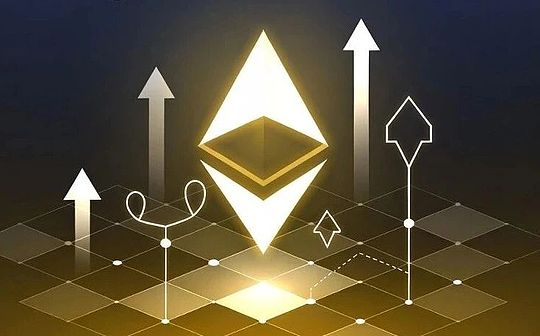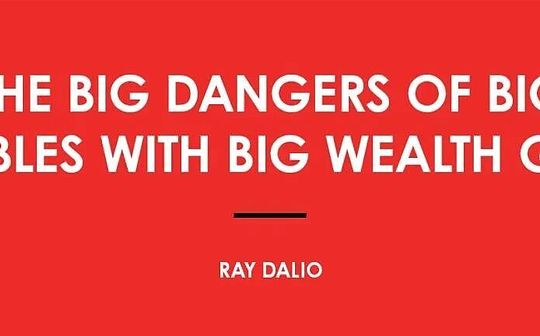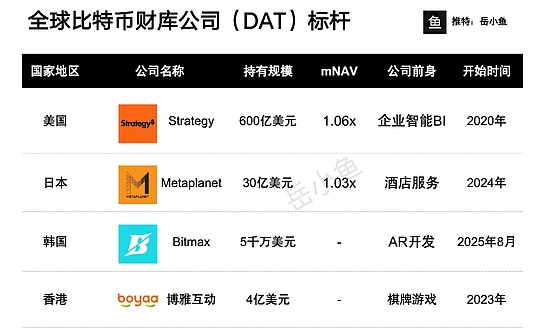
Traditional blockchain network valuation methods often have misunderstandings, treating blockchain networks as enterprises and using formulas designed specifically for calculating fair prices of stocks, which are based on very narrow considerations only.This approach has fundamental drawbacks.
Blockchain, especiallySmart contract platforms like Ethereum are not enterprises.As I explained in my previous article, they are emerging, sovereign digital economies with their own reserve currency.These currencies not only serve their native network, but also play the role of store of value (SoV), unit of valuation (UoA), and medium of exchange “overseas” – taking $ETH as an example, its role is not limited to the original main network,Infiltrate and become a reserve currency in multiple extension networks (L2) that fall under their monetary jurisdiction and flourish even outside these boundaries (similar to how the US dollar works today).
In addition, Proof of Stake Blockchain (POS) introduces a mechanism similar to bonds where participants collateralize assets to protect the network in exchange for future returns.These dynamics reflect the structure of the nation-state economy, financial instruments supporting its national defense, and current and future operational stability.
in other words,Blockchain networks like Ethereum based on smart contracts are becoming an emerging network country – a digital country, they are not only shown through the technology stack, but also through monetary jurisdictions and reserve currencies, common values and beliefs, common history and culture, and sometimes fundamental myths.
Gross Decentralized Product
To meet the demand for more appropriate valuation frameworks in these emerging digital economies, we proposeDecentralized GDP(Gross Decentralized Product, referred to as GDP), this method can not only capture the total amount of money, but also capture the economic activity of the blockchain ecosystem.Unlike the GDP of traditional economies, decentralized GDP covers a wider range:It takes into account the economic activity generated within the ecosystem and monetary base, as well as the market value of protocols, decentralized applications and cultural assets built on specific blockchains..
The theoretical basis behind this extended framework isThe paradigm shift represented by the blockchain economy.Although these ecosystems have similarities with traditional national economies, their fundamental difference is that every aspect of the economy becomes fluid and has some degree of monetary nature.In this paradigm,Output and production factors are not only components of the economy, they have also become the form of “money” that can be traded and monetized on the chain..
Therefore, the most effective way to invest in such blockchain economies is through their native currency.These currencies support all economic activity on the blockchain through programmatically set supply caps.Their value is closely related to the growth of the system, which is reflected in the rising market value.Over time, the native assets of the most successful blockchain economies will generate a monetary premium, becoming the most primitive form of collateral in their ecosystem, gaining store of value (SoV) in the wider crypto field and even in the real world.) The status of reserve assets.
Below, we outline the key metrics that make up this framework by taking Ethereum and other leading blockchain networks as examples.
ℹ️ All data used in this article are from Token Terminal, DeFiLlama and NFT Price Floor as of November 26, 2024.
Market value: Measure currency sovereignty
The market value of blockchain native currencies can be used as a representative of their monetary basis and economic scale, similar to the role of the US M2, M3 and M4 supply on the US dollar.As mentioned earlier, sometimes the monetary basis is not limited to the main network of the blockchain, as its native currency becomes a reserve for a series of network expansions (such as L2s/L3s of ETH) and even other blockchains outside the same currency jurisdictionOn the other hand, these assets can also be transferred through bridges.It should be noted again that since the monetary basis (supply) of blockchain cannot be increased at will, the phenomenon we observe is whether when its native economy expands, or when its native currency transcends its own network boundaries and colonizes foreign economies.In this way, it is an increase in its legal value to maintain and support economic growth.This is why every time we mention the currency basis, it refers to market value.
If we take the simplest total amount of currency (M1/M2) as an indicator, then the top blockchain economies are:
-
BTC: USD 1820 billion
-
ETH: US$400 billion
-
SOL: $108 billion
-
BNB: $90 billion
-
TRON: $16 billion
Including LST and LRT tokens here is like measuring the M3 or M4 money supply in a blockchain economy based on smart contracts.Take ETH as an example, M1/M2 is $420 billion, M3 is $467 billion (LST), and M4 is $481 billion (LST + LRT).
Total Locked Value (TVL): Capital Utilization in DeFi
TVL measures the value of assets locked in the Decentralized Finance (DeFi) protocol.Critics question its utility, but it remains a powerful indicator of active economic activity on blockchain.For decentralized economies, this indicator is similar to tracking the scale of financial intermediary activities in the national economy.Not only that, it illustrates the reliability and security of monetary jurisdictions, and its ability to attract investors who want not only short-term transactions but also to keep their wealth for longer.
Top blockchain economies ranked by TVL:
-
ETH: US$66.6 billion
-
SOL: US$9.25 billion
-
TRON: US$8 billion
-
BNB: US$5.5 billion
-
BTC: US$4.4 billion
L1 Transaction Fee: Income from Economic Activities
The fees incurred by blockchain reflect the importance users attach to accessing their services.These fees represent the blockchain’s “tax income” and are directly included in its GDP.Having a strong and sustainable expense market is fundamental, and it must be balanced to provide global accessibility to users and protocol/application deployers, maintain operational stability and network security while ideally offsetting currency issuance.Otherwise, you might end up trapping in a dysfunctional system, like we see today in debt-ridden economies.
Top blockchain economies ranking by annual fee income:
-
ETH: US$2.6 billion
-
TRON: US$1.87 billion
-
BTC: US$1.23 billion
-
SOL: $590 million
-
BNB: $191 million
To do this calculation, we ignore the REV because a) it is not a protocol enforced at the mainnet level, and b) Although not all forms of MEV are extremely harmful to users, many forms are so, and there is reason to think thatThey will gradually tend to zero and most will be captured by applications that try to return it to users who offer more favorable rates.
Stablecoin: Foreign investment and currency integration
Stablecoins represent foreign investment in blockchain economies.Similar to TVL (total locked value), stablecoins are an important indicator for measuring the ability of blockchain to attract foreign investment. In other words, how blockchain introduces real-world assets (RWA).Among all major blockchains, Ethereum dominates its main network, with $101 billion hosting and another $10 billion on Layer 2.
Blockchain’s stablecoin holdings:
-
ETH: $101 billion (+L2 $10 billion)
-
TRON: $59 billion
-
BNB: US$5.8 billion
-
SOL: US$4.65 billion
-
BTC: About $1 billion (Omni)
While not a stablecoin or real-world asset (RWA), packaged versions of BTC (such as WBTC and cbBTC) can also serve as an interesting indicator of foreign investment in smart contract-based blockchain economies.In this case, Ethereum stands out as the most dynamic economy, hosting $15 billion worth of packaged Bitcoin in its mainnet and Tier 2 ecosystem.
Protocols, applications and NFTs: Economic infrastructure and culture
In blockchain economies, protocols, applications, and NFTs play similar roles to the industrial and cultural sectors in traditional economies.Protocols and applications are the infrastructure and factories that drive value creation, including decentralized finance (DeFi), social finance (SocialFi), decentralized scientific research (DeSci), etc.NFT, on the other hand, represents the cultural, entertainment and media industries, a key component of the soft power of blockchain networks, because as we said in the previous article, culture is an integral part of its influence and identity.
Ethereum dominates both sectors, with the total value of homogeneous tokens (excluding stablecoins and liquid staking tokens) being approximately $110 billion and the total value of NFTs being $4.1 billion.This highlights Ethereum’s leadership at the economic and cultural level.
-
ETH: Homogenized assets are approximately US$110 billion, and non-homogenized assets are approximately US$4.1 billion
-
SOL: Fixable assets of approximately US$18 billion, irreplaceable assets of approximately US$100 million
-
BTC: Non-fungible assets of approximately US$500 million
The data is based on CoinGecko’s top 100 market capitalization cryptocurrencies and NFT Price Floor’s top 50 NFTs.
Protocol and application costs: Economic activities of enterprises in blockchain economies
To further deepen our understanding of blockchain economic activity, we analyzed the fees incurred by top protocols and applications hosted on each blockchain.This indicator can serve as a representative of the economic output of companies and organizations operating in these ecosystems, similar to the contribution of a business to a country’s GDP.
Ethereum is far ahead, with its top protocols incurring $6 billion in fees, reflecting its position as the most mature and diversified blockchain economy.Following closely behind are Solana and BNB Chain, which are quite active but smaller in scale.
Estimates of the top 50 protocols and applications for blockchain economy:
-
ETH: About $6 billion
-
SOL: About $1.95 billion
-
BNB: About $300 million
These figures also take into account the share of fees generated by the top stablecoin issuers operating on the blockchain.Given the large volume of transactions involving stablecoins in various protocols, stablecoin issuers such as Tether (USDT) and Circle (USDC) have made significant contributions to the overall fee base.
By incorporating this metric into our overall decentralized product framework, we can gain a deeper understanding of the economic vitality of the blockchain ecosystem and the level of corporate activity it carries.
By combining these indicators, the concept of decentralized total output value provides a more comprehensive way to measure the blockchain economy.It highlights the complexity, breadth, and potential of global economic integration.
Determining how to measure and integrate the different indicators that make up the blockchain economy GDP is the task of professional economists in the future.Currently, we can simply summarize these numbers to compare the two largest smart contract-based blockchain economies:
-
ETH:1) $400 billion + 2) $66.6 billion + 3) $2.6 billion + 4) $101 billion / $110 billion + 5) $114 million + 6) $6 billion = $700 billion
-
SOL:1) $108 billion + 2) $9.25 billion + 3) $590 million + 4) $4.65 billion + 5) $18 billion + 6) $1.95 billion = $142.5 billion
As the largest and most diverse smart contract-based decentralized economy, Ethereum has performed strongly in monetary sovereignty, DeFi activity, revenue generation, stablecoin liquidity and cultural impact.
The total value of the Ethereum economy (excluding the monetary basis) is$300 billion, the ratio of its monetary basis to its total value is1.33.Since $ETH has the characteristics of “triple attribute assets” and can penetrate into “external” blockchain networks, comparison with US economies requires referenceM3/GDPorM4/GDPThe ratio is currently in1.2 to 1.5between.
As blockchain networks continue to evolve, a GDP-like framework will help investors, policy makers and developers better understand its true value as a digital sovereign economy.At the same time, indicators such as Gini coefficient and economic diversity index may also have important value in evaluating the economic health and future potential of these ecosystems.It should be emphasized that this is not about determining the fair value of the company’s shares, but about how to fully participate in the entire blockchain economy.
Let’s take the 1940sThe US economy was in an economic boom.How could investors at that time have extensive access to the “US market”?
These options may include:
-
USD: To gain liquidity and exposure to reserve currencies.
-
Treasury bonds:Before the emergence of the Petro Dollar in 1971, Treasury bonds were only used as debt instruments and had not yet become a means of global store of value.
-
stock:To achieve growth-oriented returns.
-
Art:New York has gradually become the center of world art.
As we have seen, exposure to traditional economies involves investing in a variety of assets that ultimately perform differently based on macroeconomic conditions: the dollar may strengthen during uncertain times, bonds provide security during economic downturns, and stocks thrive during expansion times.
Obtain blockchain economic exposure
In a smart contract-based economy (taking Ethereum as an example), native currency provides a unique advantage as a triple attribute asset: it acts as a simultaneouslyReserve currencies, storage means and bonds(When pledged).Unlike having a carefully configured portfolio with assets with different characteristics, a single asset (such as $ETH) provides integrated exposure to the entire blockchain economy.
This streamlined approach simplifies investment decisions while combining incentives with network growth and security.You can also add a basket of native DeFi protocols and blue chip NFTs for the blockchain economy, and it’s all ready!
Applying GDP model to estimate the future value of blockchain economy
As we highlight throughout the article, frameworks designed for joint-stock companies should not be used to value blockchain native currencies.Blockchain economies are more easily understood and evaluated as digital counterparts to traditional nation-states, the latter appeared after the Treaty of Westphalia – and it was also the period when joint-stock companies began to appear.Similar to traditional nation-states, blockchain economies are also in a state of constant competition for capital, security and human resources (i.e. developers, users, and settlers in the general sense).This is exactly why crypto-tweet mentality is instinctively recognized – so tribalism and maximizationism emerge.This is human nature: when a community feels threatened, its immune system is activated to protect a concept, technology, or a set of values that are considered valuable.
It should be noted that although blockchain economies have some similarities with traditional nation-states, they represent a completely new paradigm.In these ecosystems,The boundaries between finance and other economic sectors become blurred, so much so that everything: even art, entertainment, and attention, has reached a certain level of monetization.This liquidity makes it difficult to distinguish the monetary base from the GDP it represents.However, traditional economies remain our closest reference point and provide a benchmark for predicting the growth of blockchain economies.
Now, as a mind experiment, let’s imagine what this means for ETH price if the growth story of Ethereum can rival the rise of the most extraordinary nation-state in the past century.The current total economic output of Ethereum (excluding the monetary basis) is$300 billion, this is withChina’s economy in 1986The scale is comparable.It took about 30 years for China to grow GDP to18 trillion US dollars, this number is equivalent to the current market value of gold.China’s economic growth is extremely extraordinary, and it is a rare feat for an economy of its size.But it’s interesting to think of a world where network countries like Ethereum can replicate this unprecedented rate of economic growth.
While this comparison may have already surprised you, in my opinion, leading blockchain economies do have reason to compete with the performance of modern nation-states:
-
Digital and open
-
Global accessibility
-
No capital controls
-
Suitable for financial infrastructure as an AI-dominated economy
Assuming network countries flourish, Ethereum consolidates its dominance in the extremely expanding DeFi and AI fields, the eventual bull market emerges, and by 2054, the total economic value of the Ethereum network will reach USD 18 trillion, compared with China’s past 30The development trajectory of the year matches!Under this assumption, how will we apply the GDP model to calculate the price of ETH?
If we adopt a conservative monetary base/economic total ratio of 1.2 (similar to the current U.S. M3/GDP ratio), Ethereum’s market capitalization will reach $21.6 trillion, resulting in an ETH price of $180,000 (not considering due to expense destructionThe potential monetary base deflation caused by it).However, if we consider the possibility that Ethereum has surpassed its native ecosystem, similar to the US dollar becoming ubiquitous through the Euro-dollar system, it can achieve a monetary base/total value ratio of 1.5 (compared to the US M4/GDP ratio).In this case, Ethereum’s market capitalization will reach $27 trillion, equivalent to an ETH price of $225,000.
Now, this is not any form of ETH price forecast or financial advice, but it is really interesting to think about how the GDP framework provides a powerful perspective to understand blockchain economies and reveal their true face as emerging digital countries or economies.This framework also highlights that, like traditional national economies, multiple dimensions must be evaluated before making investment decisions.
In this framework, the reason for investing in Ethereum is its position as the most dynamic and diversified blockchain economy, whose ecosystem covers a wide range of areas from financial services to cultural products, which not only gives it a strongHard power has also established significant soft power.This is further demonstrated by Ethereum’s ability to attract and retain “sticky capital”, a signal that investors see it as the safest and most promising smart contract-based economy despite short-term price volatility, used to preserve the value of long-term wealth.







